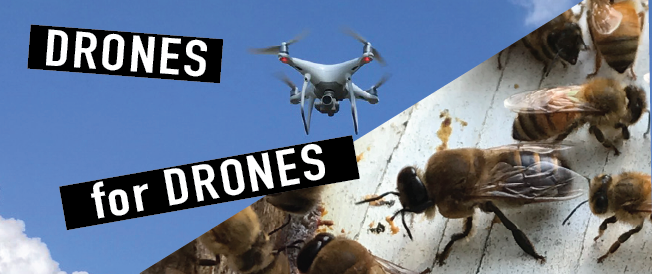DCA Hunter

Stephen Fleming has been hunting DCAs for years, specifically on the small Isles of Scilly , an archipelago off the southwestern tip of Cornwall, England, where it’s windy, chilly, and frequently rains. The honey bees there are a genetic mix but with predominantly dark bees on two of the islands. They must adapt to what we might consider inhospitable conditions. They fly quite low to the ground, in most cases just three to four meters high. This has made it easy to look for DCAs using lure hoisted by a pole, and to scoop samples with a simple bug catching net.
The most fascinating thing about these DCAs however is behavior that Stephen has seen multiple times now: “I believe a lot of drones are not flying but sitting somewhere and watching and smelling for action. That way they don’t need to return so often for refueling. I have often thought this was the case but at one site this year it was very obvious that many were sitting on brambles and bracken and then rising into action when the lure was hoisted.”
This makes sense in an area where flying can be treacherous. I thought perhaps these bees, being isolated on these islands, had evolved this behavior of resting and waiting, but Robyn Underwood, an apiculture educator at Penn State told me that she once was at a DCA over a corn field where she observed the drones taking flight from the corn stalks when a rock was tossed into the air! People often ask me if the drones are resting in the treetops. I’ve assumed not, just from what I’ve read, but given these observations it makes sense that they could also be resting in the treetops when there’s no action in the sky.
Hear the buzz…
This podcast interview with Stephen Fleming takes you to the DCA in Selborne, England, which has had drone activity reported since 1792! It’s pretty cool audio, and an excellent interview with this drone whisperer!





 Central to honey bee mating are drone congregation areas (DCAs). I discuss how to locate DCAs using unmanned aerial devices (aka, drones) in this podcast interview with PolliNation presented by Oregon State University.
Central to honey bee mating are drone congregation areas (DCAs). I discuss how to locate DCAs using unmanned aerial devices (aka, drones) in this podcast interview with PolliNation presented by Oregon State University.
 Mentoring beekeepers is a passion of mine, and it’s been a true pleasure to teach the women at the Arrendale State Prison, many of who go on to become certified beekeepers. I talk more about the program with Mandy at Beekeeper Confidential.
Mentoring beekeepers is a passion of mine, and it’s been a true pleasure to teach the women at the Arrendale State Prison, many of who go on to become certified beekeepers. I talk more about the program with Mandy at Beekeeper Confidential.
 At Georgia’s Arrendale State Prison, women inmates forge a bond by keeping bees. The class gives inmates a sense of community and teaches them skills to find work if they become eligible for release. It’s been my pleasure to teach these women since 2016 and share about the program with Atlanta Magazine.
At Georgia’s Arrendale State Prison, women inmates forge a bond by keeping bees. The class gives inmates a sense of community and teaches them skills to find work if they become eligible for release. It’s been my pleasure to teach these women since 2016 and share about the program with Atlanta Magazine.